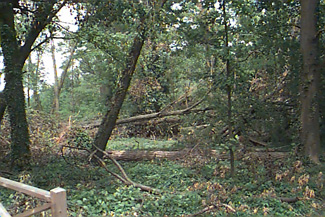Repairing ornamental plants and trees from storm damage
Take care of your landscape plants and trees after severe storms, as some injuries could be permanent.
|
|
Summer waves of storms that sweep through parts of Michigan often leave a number of people temporarily without power as a result of downed trees and broken limbs. Wind and water has changed many landscapes, some forever. Heavy rains, hail and winds can cause flooding and massive erosion in some areas, and downed or uprooted trees, shrubs and plants are commonly left in a storm’s wake. Some plants and trees are bent and broken; others are just jagged stumps. Much of this is temporary, but some damage is permanent. The water will drain and gullies gouged out by the rain can be filled, but the loss of large branches and whole mature plants and trees will take many years to replace, if ever.
If you experienced damage to plants or trees in your yard, the first thing you probably want to do is to clean up and assess the damage. Give your attention first to safety and address issues where power lines or people may be in danger of downed branches or trees. If power lines are involved, only your utility company should handle those. Serious damage to trees where more than one-third of the tree is lost or very large sections of the bark are torn away will probably result in the death of the tree and it should be removed. In other cases, small broken branches and small areas of torn bark can be do-it-yourself repairs. You simply need to prune the rough edges where branches have been broken, neatly trim the jagged edges of the open bark with a sharp knife to promote uniform healing, and clean-rake the yard of shredded plant material.
Expect to see the tear holes and shreds on leaves still on the trees and shrubs in the months to come. This will not self-repair and in some cases the tree will continue to shed these damaged leaves as they grow new leaves as replacements. This is normal and our woody plants have adapted to these conditions. Smaller plants and shrubs can be pruned to remove the damaged branches and leaves – up to one-third of the plant can be safely removed. Some shrubs can withstand a periodic “rejuvenation” cut following severe damage, but not many and not often.
Broken branches and blown over trees should be removed. If you have large, broken branches, you will want to prune the jagged part of the branch back to an undamaged part to prevent further breakage and promote healing. Even oak trees should be cared for after a storm event; wounds with jagged edges are harboring places for insects and disease. Oak trees should have their wounds sealed with tree wound compound or a water-based paint to further help protect them from sap-feeding insects that spread the fungal disease, oak wilt. Some trees are more prone to breakage than others, for example Chinese elm and silver maple are brittle trees and seem to regularly lose leaves, branches and limbs. Tree splits can many times be repaired with cabling the two pieces back into place.
It is important to note that some plants and trees may have an existing fungus or disease. Therefore, it is very important to clean your cutting and pruning tools between plants with a quarter cups of chlorine bleach in a gallon of water as a dip, or wipe thoroughly with a sanitizing cleaning product containing chlorine bleach.
For more information, contact your local Michigan State University Extension office and ask for Bulletin E-1364, Repairing Storm Damage to Trees.
Related resources:
- Storm Recovery - Trees, Arbor Day Foundation



 Print
Print Email
Email





